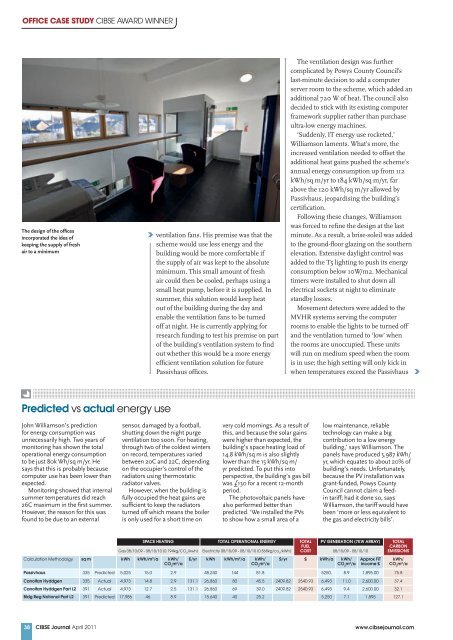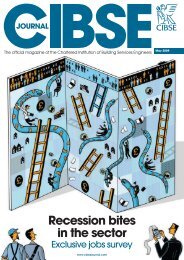Create successful ePaper yourself
Turn your PDF publications into a flip-book with our unique Google optimized e-Paper software.
Office c<strong>as</strong>e study cibse AwArd winner<br />
The design of the offices<br />
incorporated the idea of<br />
keeping the supply of fresh<br />
air to a minimum<br />
Predicted vs actual energy use<br />
John Williamson’s prediction<br />
for energy consumption w<strong>as</strong><br />
unnecessarily high. Two years of<br />
monitoring h<strong>as</strong> shown the total<br />
operational energy consumption<br />
to be just 80k Wh/sq m/yr. He<br />
says that this is probably because<br />
computer use h<strong>as</strong> been lower than<br />
expected.<br />
Monitoring showed that internal<br />
summer temperatures did reach<br />
26C maximum in the first summer.<br />
However, the re<strong>as</strong>on for this w<strong>as</strong><br />
found to be due to an external<br />
38<br />
ventilation fans. His premise w<strong>as</strong> that the<br />
scheme would use less energy and the<br />
building would be more comfortable if<br />
the supply of air w<strong>as</strong> kept to the absolute<br />
minimum. This small amount of fresh<br />
air could then be cooled, perhaps using a<br />
small heat pump, before it is supplied. In<br />
summer, this solution would keep heat<br />
out of the building during the day and<br />
enable the ventilation fans to be turned<br />
off at night. He is currently applying for<br />
research funding to test his premise on part<br />
of the building’s ventilation system to find<br />
out whether this would be a more energy<br />
efficient ventilation solution for future<br />
P<strong>as</strong>sivhaus offices.<br />
sensor, damaged by a football,<br />
shutting down the night purge<br />
ventilation too soon. For heating,<br />
through two of the coldest winters<br />
on record, temperatures varied<br />
between 20C and 22C, depending<br />
on the occupier’s control of the<br />
radiators using thermostatic<br />
radiator valves.<br />
However, when the building is<br />
fully occupied the heat gains are<br />
sufficient to keep the radiators<br />
turned off which means the boiler<br />
is only used for a short time on<br />
calculation Methodolgy sq m kwh kwh/m 2 /a kwh/<br />
Co 2 m 2 /a<br />
very cold mornings. As a result of<br />
this, and because the solar gains<br />
were higher than expected, the<br />
building’s space heating load of<br />
14.8 kWh/sq m is also slightly<br />
lower than the 15 kWh/sq m/<br />
yr predicted. To put this into<br />
perspective, the building’s g<strong>as</strong> bill<br />
w<strong>as</strong> £130 for a recent 12-month<br />
period.<br />
The photovoltaic panels have<br />
also performed better than<br />
predicted. ‘We installed the PVs<br />
to show how a small area of a<br />
The ventilation design w<strong>as</strong> further<br />
complicated by Powys County Council’s<br />
l<strong>as</strong>t-minute decision to add a computer<br />
server room to the scheme, which added an<br />
additional 720 W of heat. The council also<br />
decided to stick with its existing computer<br />
framework supplier rather than purch<strong>as</strong>e<br />
ultra-low energy machines.<br />
‘Suddenly, IT energy use rocketed,’<br />
Williamson laments. What’s more, the<br />
incre<strong>as</strong>ed ventilation needed to offset the<br />
additional heat gains pushed the scheme’s<br />
annual energy consumption up from 112<br />
kWh/sq m/yr to 184 kWh/sq m/yr, far<br />
above the 120 kWh/sq m/yr allowed by<br />
P<strong>as</strong>sivhaus, jeopardising the building’s<br />
certification.<br />
Following these changes, Williamson<br />
w<strong>as</strong> forced to refine the design at the l<strong>as</strong>t<br />
minute. As a result, a brise-soleil w<strong>as</strong> added<br />
to the ground-floor glazing on the southern<br />
elevation. Extensive daylight control w<strong>as</strong><br />
added to the T5 lighting to push its energy<br />
consumption below 10W/m2. Mechanical<br />
timers were installed to shut down all<br />
electrical sockets at night to eliminate<br />
standby losses.<br />
Movement detectors were added to the<br />
MVHR systems serving the computer<br />
rooms to enable the lights to be turned off<br />
and the ventilation turned to ‘low’ when<br />
the rooms are unoccupied. These units<br />
will run on medium speed when the room<br />
is in use; the high setting will only kick in<br />
when temperatures exceed the P<strong>as</strong>sivhaus<br />
low maintenance, reliable<br />
technology can make a big<br />
contribution to a low energy<br />
building,’ says Williamson. The<br />
panels have produced 5,987 kWh/<br />
yr, which equates to about 20% of<br />
building’s needs. Unfortunately,<br />
because the PV installation w<strong>as</strong><br />
grant-funded, Powys County<br />
Council cannot claim a feedin<br />
tariff; had it done so, says<br />
Williamson, the tariff would have<br />
been ‘more or less equivalent to<br />
the g<strong>as</strong> and electricity bills’.<br />
SPaCE HEatIng total oPEratIonal EnErgy total PV gEnEratIon (7kw array) total<br />
fuEl<br />
CarBon<br />
G<strong>as</strong> 08/10/09 - 08/10/10 (0.194kg/cO /kwh) 2 electricity 08/10/09 - 08/10/10 (0.568kg/co /kwh) 2 CoSt<br />
08/10/09 - 08/10/10 EmISSIonS<br />
£/yr kwh kwh/m 2 /a kwh/<br />
Co 2 m 2 /a<br />
£/yr £ kwh/a kwh/<br />
Co 2 m 2 /a<br />
approx fit<br />
income £<br />
P<strong>as</strong>sivhaus 335 Predicted 5,025 15.0 2.9 48,240 144 81.8 5250, 8.9 1,895.00 75.8<br />
Canolfan Hyddgen 335 Actual 4,973 14.8 2.9 131.1 26,860 80 45.5 2409.82 2540.93 6,493 11.0 2,600.00 37.4<br />
Canolfan Hyddgen Part l2 391 Actual 4,973 12.7 2.5 131.1 26,860 69 39.0 2409.82 2540.93 6,493 9.4 2,600.00 32.1<br />
Bldg reg notional Part l2 391 Predicted 17,986 46 8.9 15,640 40 25.2 5,250 7.1 1,895 127.1<br />
kwh/<br />
Co 2 m 2 /a<br />
<strong>CIBSE</strong> <strong>Journal</strong> April 2011 www.cibsejournal.com







